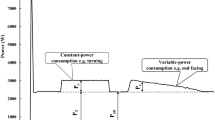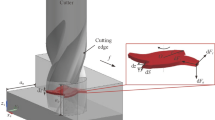Abstract
Nowadays, the accurate calculation and evaluation of processing carbon emissions (which refer to the total carbon emissions emitted by CNC consuming electrical energy during machining process) have become a hot topic owning to their great role on optimizing cutting processes, and thus reducing the global carbon dioxide emissions. However, the existing carbon emission calculation models for machining process do not pay much attention to the effect of tool wear on processing carbon emissions, which leads to the inaccurate evaluation. So in this paper, a practical carbon emission model for machining process is carried out. The model consists of two parts: (1) a relationship between processing carbon emissions and cutting power (which is the power only caused by removing materials from workpiece) and (2) a novel cutting power model considering tool wear condition. Afterwards, orthogonal experiments are performed on three different CNC machine tools in order to fit cutting power model’s constants and coefficients. Experiment results and related data analysis indicate that the presented cutting power model and the experimental evaluation method are accurate, and the flank wear length (VB), which is the index of evaluating tool wear condition, is necessary to be introduced as an independent variable. Compared with other models which do not consider the tool wear condition, this model succeeds to improve the calculation precision of processing carbon emissions, and provides more accurate data supporting the cutting parameter optimization.
Similar content being viewed by others
References
Liu ZJ, Sun DP, Lin CX, Zhao XQ, Yang Y (2016) Multi-objective optimization of the operating conditions in a cutting process based on low carbon emission costs. J Clean Prod 124(Supplement C):266–275
Zhou LR, Li JF, Li FY, Meng Q, Li J, Xu XS (2016) Energy consumption model and energy efficiency of machine tools: a comprehensive literature review. J Clean Prod 112(Part 5):3721–3734
Miranda J, Camposeco-Negrete C, Calderón J (2016) Optimization of cutting parameters to minimize energy consumption during turning of AISI 1018 steel at constant material removal rate using robust design. Int J Adv Manuf Technol 83:1341–1347
Li CB, Li LL, Tang Y, Zhu YT, Li L (2016) A comprehensive approach to parameters optimization of energy-aware CNC milling. J Intell Manuf 1–16
Peng T, Xu X (2017) An interoperable energy consumption analysis system for CNC machining. J Clean Prod 140(Part 3):1828–1841
Kordonowy DN (2002) A power assessment of machining tools. Massachusetts Institute of Technology, Cambridge
Dietmair A, Verl A (2009) Energy consumption forecasting and optimisation for tool machines. MM Sci J 3:62–67
Draganescu F, Gheorghe M, Doicin CV (2003) Models of machine tool efficiency and specific consumed energy. J Mater Process Technol 141(1):9–15
Gutowski T, Dahmus J, Thiriez A (2006) Electrical energy requirements for manufacturing processes. Proceedings of the 13th CIRP International Conference on Life Cycle Engineering, Leuven, Belgium, May 31–June 2, 2006
Zhong Q, Tang RZ, Lv JX, Jia S, Jin M (2016) Evaluation on models of calculating energy consumption in metal cutting processes: a case of external turning process. Int J Adv Manuf Technol 82(9):2087–2099
Guo Y, Loenders J, Duflou JR, Lauwers B (2012) Optimization of energy consumption and surface quality in finish turning. Procedia CIRP 1:512–517
Xie J, Liu F, Qiu H (2016) An integrated model for predicting the specific energy consumption of manufacturing processes. Int J Adv Manuf Technol 85(5):1339–1346
Liu N, Zhang YF, Lu WF (2015) A hybrid approach to energy consumption modelling based on cutting power: a milling case. J Clean Prod 104:264–272
He Y, Liu F, Wu T, Zhong FP, Peng B (2012) Analysis and estimation of energy consumption for numerical control machining. Proc Inst Mech Eng B J Eng Manuf 226(2):255–266
Liu ZY, Guo YB, Sealy MP, Liu ZQ (2016) Energy consumption and process sustainability of hard milling with tool wear progression. J Mater Process Technol 229(Supplement C):305–312
Grzesik W, Denkena B, Żak K, Grove T, Bergman B (2015) Energy consumption characterization in precision hard machining using CBN cutting tools. Int J Adv Manuf Technol 85:2839–2845
Wang Q, Liu F, Wang X (2013) Multi-objective optimization of machining parameters considering energy consumption. Int J Adv Manuf Technol 71(5–8):1133–1142
Moradnazhad M, Ünver HÖ (2017) Energy consumption characteristics of turn-mill machining. Int J Adv Manuf Technol 91(5):1991–2016
Altıntaş RS, Kahya M, Ünver HÖ (2016) Modelling and optimization of energy consumption for feature based milling. Int J Adv Manuf Technol 86(9):3345–3363
Kolar P, Fojtu P, Schmitz T (2015) On cutting force coefficient model with respect to tool geometry and tool wear. Procedia Manuf 1(Supplement C):708–720
Zhang BJ, Song SM, Chen M (2010) Study of cutting force model based on tool condition. Tool Eng. (02):27–30. (In Chinese)
Rizal M, Ghani JA, Nuawi M, Che Haron CH (2013) The application of I-kazTM-based method for tool wear monitoring using cutting force signal. MITC2013 68:461–468
Zhou GH, Zhou C, Lu Q, Tian C, Xiao Z (2017) Feature-based carbon emission quantitation strategy for the part machining process. Intl J Comput Integr Manuf 11:1–20
Zhou GH, Lu Q, Xiao ZD, Zhou C, Yuan SZ, Zhang C (2017) Ontology-based cutting tool configuration considering carbon emissions. Int J Precis Eng Manuf 18(11):1641–1657
Uehara K, Kiyosawa F, Takeshita H (1979) Automatic tool wear monitoring in NC turning. CIRP 28(1):38–42
Acknowledgments
This research is supported by the National Natural Science Foundation of China (grant no. 51575435).
Author information
Authors and Affiliations
Corresponding author
Additional information
Publisher’s Note Springer Nature remains neutral with regard to jurisdictional claims in published maps and institutional affiliations.
Rights and permissions
About this article
Cite this article
Zhou, G., Yuan, S., Lu, Q. et al. A carbon emission quantitation model and experimental evaluation for machining process considering tool wear condition. Int J Adv Manuf Technol 98, 565–577 (2018). https://doi.org/10.1007/s00170-018-2281-6
Received:
Accepted:
Published:
Issue Date:
DOI: https://doi.org/10.1007/s00170-018-2281-6




